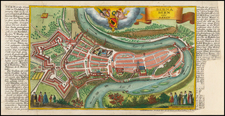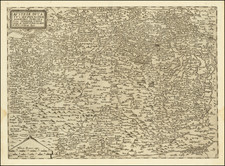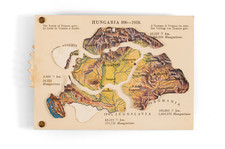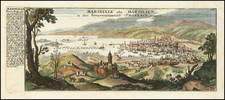"The Silent State" -- Rare 1885 State of Haardt's Monumental Map of the Alps
First Modern Large Scale Map of the Alps
Highly acclaimed large format map of the Alpine regions of Europe, created by famed mapmaker Vincenz von Haardt an d published in Vienna.
The present map is the first large format map of the Alpine Regions of Europe. As noted below in the contemporary review, Haardt's map of the Alps was an important improvement in the mapping of the region, being the first large scale map of the entire Alps produced during this period.
The present example is unrecorded second state of what the reviewer below refers to has "the Silent State," based upon its lack of toponyms. Haardt first issued a map with the same title in 1882, which is also exceptionally rare. The following review of the first state of Haardt's map appeared in the February 10, 1883 edition of Deutsche Litteraturzeitgung Nr. 6 (1883).
Geography and Ethnology.
Alps Wall Map based on the design and under the direction of Vincenz von Haardt. 6 sheets with an explanatory booklet. Scale 1:600,000. Detailed Edition. Explanations to the Wall Map of the Alps by V. von Haardt. With a map: Division of the Alps. Scale: 2,000,000. 1889. 37 pages. M. 30 Vienna, Hölzel.
A good wall map of the entire Alps region has long been a pressing need. Until now, one had to make do with individual parts of the area as provided by maps of France, Switzerland, Austria, etc., or with representations that only included the Alps region as a secondary focus, which was quite inconvenient. Now, this need has been excellently met by Haardt's map, which already attracted the attention of geographers at Verona. The author has released three editions: besides the current one, there is a school edition with reduced nomenclature and highlighted main features for elementary education purposes, and a "silent" edition that only shows the river network and topography. All three editions are of the same size, covering the Alps region in the widest extent from 22º to 38º 8' E longitude and from 43º to 48° 40' N latitude in de l'Isle's projection. The map scale of 1:600,000 results in a large size, including the Vosges, Black Forest, the Rhone area, the Bavarian Plateau, the Danube (with Tisza) up to Belgrade, the Little Carpathians, part of the Hungarian highlands, the Drin area, a large part of the Adriatic, Italy, etc., within its frame. The first edition, our main focus here, offers a very clear and excellently detailed image despite its rich nomenclature, in beautiful color printing (sea, lakes, marshes in light blue, rivers in dark blue, glaciers in white and blue, lowland in green, upland in light brown, mountain land in dark brown, roads, railways, names in black). Particularly valuable is the depiction of river courses . . . which allows them to be color-coded, not black, in color printing, clearly and distinctly differentiating them from roads and railways, as vividly and instructively demonstrated on V. von H.'s map. Special effort has naturally been made on the main content, the terrain, the mountain depiction. As part of the recognition belongs to Mr. Em. Schossig for the river network, the work of the terrain illustrator, Mr. Th. Fees, must be commendably highlighted. The land's relief is excellently brought out through the very insightful use of lighting, mostly taken from the northwest, as on the Dufour maps, in the majority of the Alps. However, in other parts, the direction of lighting changes; in the eastern Alps, there's sometimes a north-south direction, in Croatia, Dalmatia an northeastern one, and the more peripheral, less elevated parts of the map show vertical lighting. This variety, applied with as much taste as orographic expertise, is very effective: it highlights the main features while accurately reflecting the nature of the land.
The map's content is incredibly rich while still maintaining clear overview. This includes the representation of the terrain itself, including coasts, bays, lakes, and further details. Heights of mountains (with peak points always marked) and most towns are everywhere found, along with many depth indications especially of the Adriatic, but also the Ligurian Sea, heights and depths in meters. Additionally, countless names up to medium-high mountains, villages under 2000 inhabitants, to streams; castles, palaces are marked, in short, the present 6 sheets contain an astonishing abundance of diligent work and comprehensive material. The terrain representation of the Alps is as accurate and correct in detail as one can expect from a wall map; and minor inaccuracies here and there in peripheral areas of the map are hardly worth mentioning.
Valuable is the comparative overview of the most important altitude points in the Alps given at the bottom edge of the map on the cut line: Varmündung, Great St. Bernard, St. Gotthard, Brenner, Hochgolling, Hochschwab, Leopoldsberg (Length 1:600,000, Height 1:100,000). This representation clearly and instructively presents the boundary of the individual Alpine massifs, their base formation, peak height and passes, the height of the lakes, etc., although schematically. The explanations offer nothing essentially new regarding the division of the Alps, as von H. himself emphasizes. One might have a different opinion on details, like the author, who would not place the boundary of the Alps north of Genoa at Bocchetta. Other boundary lines, however, are very well drawn; particularly valuable is the booklet for its detailed detailing of the individual parts of the Alps, which first provides a precise discussion of the boundary, then a general characterization of the individual parts and groups. Then, the individual outstanding mountain peaks and finally the roads and passes leading over the various parts are discussed more in detail. It involuntarily reminds one of Stieler's great orographic work (the mountains of Switzerland, hydrographically ordered), which appeared as a commentary on the first editions of the great Stieler Atlas, but unfortunately, although still of value today, has long disappeared from bookstores. Since Stieler, probably no such special orographic work on the Alps and their individual peaks has appeared as these explanations by von H., which deserve great praise for the abundance of material and the accuracy of information, as they correspond to the current state of research. The publishing house has fully maintained the good reputation it enjoys in the field of cartography: the production of the extremely difficult map is excellent.
Strasbourg
E. Georg Gerland.
Rarity
The map is extremely rare, with this 1885 edition completely unrecorded.
OCLC locates examples of the 1882 map at the University of Chicago and Lippische Landesbibliotheque.
We were unable to locate any examples in dealer catalogs or at auction.
Vinzenz Haardt von Hartenthurn was a cartographer and military geographer.
Haardt was born in Iglau (Jihlava, Moravia) on August 13, 1843, and died in Vienna on August 1, 1914. His father was a general major.
Vinzenz finished his studies at the Theresian Military Academy and the Imperial Royal War School in Vienna. He participated in the 1866 campaign in Italy, fought against the insurrection in Cattaro in 1869, and became a captain in the General Staff. By 1872, he was a professor at the Technical Military Academy and from 1877 to 1896, he was the scientific head at Eduard Hölzel. In 1897, he became the head of the 1st department at the Military Geographical Institute, was made a government councilor in 1896, and a ministerial councilor in 1912. He attended numerous international geographical congresses and the international earth map conference in London in 1909 and in Paris in 1913.
His work focused on cartography and school geography, contributing to atlas and wall maps, and writing explanations for map works. Notably, he worked on the wall map of the Alps and the text for the portable edition of the "Geograph. Charakterbilder" along with Fr. Umlauft. His research on the history of cartography, especially on the cartography of the Balkan Peninsula in the 19th and 20th centuries, the development of cartography in Austria, and the Military Geographical Institute, are of lasting value. He was also the editor of the "Mitteilungen der Geographischen Gesellschaft Wien" in 1884 and 1885.
His works include several editions of the Kozenn Atlas, the Geographic Atlas of the Austro-Hungarian Monarchy in 1883, a wall map of the Alps in 1882, an overview map of the ethnographic conditions of Asia in 1887, a South Pole map in 1895, and a hand map of Bosnia and Herzegovina in 1907, among others. He also authored significant writings on the division of the Alps, the development of cartography in Austria, and the military geographical Institute, as well as other contributions to the understanding of military topographical work in Europe and the cartography of the Balkan Peninsula.















![[ Duchy of Swabia / Bavaria and Baden-Württemberg ] A New Map of the Circle of Swabia, From The Latest Authorities . . . 1799](https://storage.googleapis.com/raremaps/img/small/99497.jpg)
![[Baden]. Designatio civitatis Badensis Helveticae, una cum oppidulo thermarum](https://storage.googleapis.com/raremaps/img/small/83126.jpg)